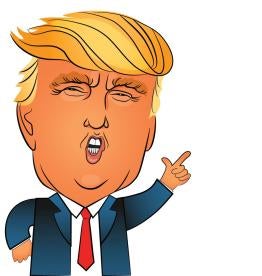As my teenage daughter would say: “Well, that happened.” As I write this, a little over one week has passed since the end of days, the rain of frogs or whatever apocalyptic description you may choose to describe the election of Donald Trump as the 45th President of these United States. Considering that the Chicago Cubs just won the World Series only a short time beforehand, one may be excused from thinking that the end of time is, indeed, at hand.
There can be no doubt that Trump’s election will upend the apple cart in Washington, D.C. For example, Trump plans on overturning a multitude of Executive Orders that the Obama Administration has issued over the last eight years. While rescinding Executive Orders sounds easy enough in concept (and probably in practice since all it takes is a signed statement revoking them), whether all of the Executive Orders concerning employment issues will be negated is less clear.
As an example, here is a brief overview of the Executive Orders the Obama Administration has rolled out concerning employers:
-
Executive Order 13495 / January 30, 2009. Requiring federal contractors and subcontractors to ensure that if their duties are taken over by a successor entity, non-managerial employees, who otherwise would be terminated by the transition, will be offered a right of first refusal in any future employment for positions for which they are qualified.
-
Executive Order 13496 / January 30, 2009. Requiring federal contractors to notify employees about federal labor laws.
-
Executive Order 13518 / November 9, 2009. Promoting the employment of veterans in the federal government.
-
Executive Order 13658 / February 12, 2014. Requiring federal contractors to pay minimum wage to any employees, workers or contractors they utilize.
-
Executive Order 13665 / April 8, 2014. Prohibiting federal contractors from discharging, discriminating against or retaliating against any employees who have discussed or disclosed the compensation information of another employee or applicant.
-
Executive Order 13672 / July 21, 2014. Prohibiting discrimination based on sexual orientation and gender identity by federal contractors.
-
Executive Order 13673 / July 31, 2014. Requiring entities interesting in contracting or subcontracting with the federal government to disclose any administrative merits determination, arbitration award or decision or civil judgment rendered against them within the last 3 years relating to federal and state labor and employment laws.
-
Executive Order 13706 / September 7, 2015. Establishing paid sick leave for federal contractors and subcontractors.
At a glance, few of these Executive Orders stand out as extremely controversial. Further, given Trump’s promises on the campaign stump to support things such as veterans’ rights and LGBTQ rights, it is unlikely that many of these will fall by the wayside come January 20, 2017. More likely, many of the Obama Administration’s Executive Orders concerning employers will be retained or will live on in some modified form.
The new FLSA “Final Rule” which goes into effect December 1, 2016, also is unlikely to fade into history – at least not entirely. The “Final Rule” increased the wage rate for the salary basis test applicable to exempt white collar employees from $455 a week or $23,660 annually to $916 a week or $47,476 annually. Changing this will be somewhat more difficult than just signing a memo. For one thing, the FLSA expressly delegates power to the Department of Labor to define the specific terms of the exemptions. As a result, nothing can happen until a new Secretary of Labor is installed.
Next, the new Secretary of Labor would have to propose a new regulation to overturn the “Final Rule.” That also will take time. Meanwhile, employers having to comply with the Final Rule by December 1 – only a few weeks from now – already will have made the necessary adjustments to deal with the regulation by raising affected worker pay to come within the new minimum threshold or converting the workers to hourly. Either way, reversing course at some point in mid-2017 could be painful for employers and employees alike (including employees in rust-belt states that delivered Trump his electoral victory and who stand to benefit from the new regulation).
That said, other government programs and initiatives affecting employers almost certainly will see significant changes. Take immigration policy. During President George W. Bush’s second term (2004-2008), Immigration and Customs Enforcement dramatically increased the number of criminal and administrative arrests arising out of worksite investigations – rising from a total of 850 in 2004, to 6,287 in 2008. Those numbers fell precipitously during the Obama years – dropping to 1,617 by 2010 and then 903 in 2014. However, as Trump was swept into office promising to get tough on illegal immigration and applying a law and order approach, it is a safe bet that the next few years will see a return to high numbers of worksite raids and arrests.
Another program that may be in jeopardy is the government’s effort to combat the misclassification of workers as independent contractors. Contracting represents a growing chunk of the workforce and, over the last eight years, the Obama Administration has focused heavily on curbing the perceived misclassification of these workers. Launched during Obama’s first term, the DOL’s misclassification initiative – a joint partnership with the IRS – has specifically targeted certain industries (i.e., janitorial, food service, hospitality) and has resulted in large dollar awards for misclassified workers. In fact, in Fiscal Year 2015, the DOL netted $74 million in back wages for 102,000 workers.
In tandem with the misclassification initiative, last year the DOL issued an “Administrator’s Interpretation” that detailed the factors the DOL believes are important in determining whether a worker is an employee or a contractor. A key aspect of this interpretation was that the DOL deliberately downplayed the importance of control over the details of the work (which historically had been regarded as a major factor) as integral to the analysis of a worker’s status. This interpretation and the DOL’s overall focus on misclassification almost certainly will be re-evaluated in the coming months (and probably reversed or significantly scaled back) by the new administration.
One week after the election, it is difficult to see exactly what the future holds for employers in the incoming Trump Administration. What is clear is that there is a lot of interest in effectuating considerable change in how things are done in Washington. Whether or not that translates to change in the real world for employers is another thing. Time will tell.



 i
i

